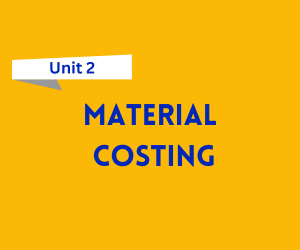Materials form a significant portion of the total production cost in most manufacturing organizations. Effective management of materials ensures uninterrupted production, cost savings, and better utilization of resources. This unit explains the procedures for purchasing materials, storekeeping practices, inventory valuation methods, and various techniques for inventory control.

Download UNIT 2 – Materials Costing and Inventory Control Notes
Get simplified revision notes for this unit:
Download Unit 2 Notes PDF
Material Purchase Procedures
Purchasing materials is the first step in material management. An effective purchase system ensures that the right material is bought in the right quantity, quality, and at the right price. The general procedure includes:
Purchase Requisition: Request raised by the production department when stock reaches the reorder level.
Enquiry and Quotation: Inviting quotations from suppliers and comparing prices.
Purchase Order: Issued to the selected supplier specifying terms like quantity, price, and delivery date.
Receiving and Inspection: Checking quality and quantity of materials received before storing them.
This systematic approach helps prevent shortages and excess inventory, reducing wastage and cost.
Storekeeping and Inventory Records
Storekeeping involves proper storage, handling, and issuing of materials to ensure safety and easy accessibility. A good store layout should minimize material handling and ensure proper preservation. Common inventory records include:
Bin Cards – Maintained in the store for each item, showing receipts, issues, and balance.
Stores Ledger – Maintained by the costing department for financial control of materials.
Proper record-keeping avoids stock-outs, pilferage, and overstocking.
Material Issues – Pricing Methods
When materials are issued to production, their cost must be determined. Common methods for valuing material issues include:
FIFO (First In, First Out): Materials purchased first are issued first. Suitable during periods of rising prices to show lower cost of goods.
LIFO (Last In, First Out): Materials purchased last are issued first. It results in higher cost of goods sold during inflation.
Weighted Average Method: Calculates a weighted average cost for all units in stock after every purchase.
Simple Average Method: Uses the simple average of purchase prices without considering quantities.
Each method affects the cost of production and closing inventory differently, impacting profitability.
Inventory Control Techniques
Effective inventory control ensures optimal stock levels to avoid excess investment or stock-outs. Key techniques include:
EOQ (Economic Order Quantity): The ideal order quantity that minimizes total ordering and carrying costs.
ABC Analysis: Classifies inventory into:
A items: High value, low quantity (strict control)
B items: Moderate value and control
C items: Low value, high quantity (simple control)
VED Analysis: Based on criticality:
Vital items: Essential for production
Essential items: Important but not critical
Desirable items: Least critical
These techniques ensure efficient working capital management and cost savings.
Perpetual and Periodic Inventory Systems
Perpetual Inventory System: Continuous updating of inventory records for receipts and issues. Helps in real-time stock control.
Periodic Inventory System: Stock levels are checked physically at periodic intervals, usually at month-end or year-end.
A perpetual system provides better control but requires advanced systems and higher costs, whereas a periodic system is simpler but less accurate.
